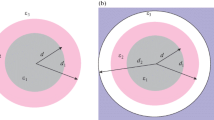Abstract
The optical properties of an ensemble of metal nanoparticles coated with an oxide layer have been investigated within framework of the classical theory. The influence of the electron-scattering mechanisms on the polarizability of nanoparticles is analyzed. The limiting case of a thin oxide layer is considered, and analytical expressions for the real and imaginary parts of the polarizability are derived. The evolution of the frequency dependences of the polarizability and extinction coefficient upon variation in the particle size and oxide-layer thickness is investigated. It is shown that the consideration of the size dependence of the surface component of the relaxation time changes the character of the size dependence of the frequency of surface plasmons of two-layer nanoparticles.





Similar content being viewed by others
REFERENCES
V. V. Kulish and P. M. Tomchuk, Surf. Sci. 602, 1045 (2008). https://doi.org/10.1016/j.susc.2007.12.030
J. M. J. Santillán, L. B. Scaffardi, and D. C. Schinca, J. Phys. D: Appl. Phys. 44, 105104 (2011). https://doi.org/10.1088/0022-3727/44/10/105104
P. Chakraborty, J. Mater. Sci. 33, 2235 (1998). https://doi.org/10.1023/A:1004306501659
H.-Y. Xia, Ch.-X. Teng, X.-W. Zhao, and J. Zheng, Chin. Phys. Lett. 29, 084215 (2012). https://doi.org/10.1088/0256-307X/29/8/084215
D. A. Zuev, S. V. Makarov, I. S. Mukhin, S. V. Starikov, I. A. Morozov, I. I. Shishkin, A. E. Krasnok, and P. A. Belov, arXiv:1601.02013 (2016).
L. G. Astafyeva, G. A. Zalesskaya, and V. Yu. Plavskii, Opt. Spectrosc. 112, 642 (2012). https://doi.org/10.1134/S0030400X12040030
R. Narayanan, C. Tabor, and M. A. El-Sayed, Top. Catal. 48, 60 (2008).
R. D’Agata, P. Palladino, and G. Spoto, Beilstein J. Nanotechnol. 8, 1 (2017). https://doi.org/10.3762/bjnano.8.1
Z. Liu, S. Y. Lee, and E.-Ch. Lee, Appl. Phys. Lett. 105, 223306 (2014). https://doi.org/10.1063/1.4903749
V. K. Pustovalov, L. G. Astafyeva, and W. Fritzsche, Sol. Energy 122, 1334 (2015).
Ch. Liu, D. Zhang, Y. Liu, D. Wu, L. Chen, R. Ma, Z. Yu, L. Yu, and H. Ye, Nanosc. Res. Lett. 12, 601 (2017). https://doi.org/10.1186/s11671-017-2363-7
V. Mlinar, Nanotechnology 24, 042001 (2013). https://doi.org/10.1088/0957-4484/24/4/042001
J. M. J. Santillán, F. A. Videla, M. B. Fernández van Raap, D. C. Schinca, and L. B. Scaffardi, J. Appl. Phys. 113, 134305 (2013). https://doi.org/10.1063/1.4798387
L. G. Astafyeva and V. K. Pustovalov, Opt. Spectrosc. 121, 109 (2016). https://doi.org/10.1134/S0030400X16070043
L. G. Astaf’eva, V. K. Pustovalov, and V. Fritche, Opt. Spectrosc. 126, 294 (2019).
S. Qu, C. Du, Y. Song, Y. Wang, Y. Gao, S. Liu, Y. Li, and D. Zhu, Chem. Phys. Lett. 356, 403 (2002). https://doi.org/10.1016/S0009-2614(02)00396-2
N. L. Rosi and C. A. Mirkin, Chem. Rev. 105, 1547 (2005). https://doi.org/10.1021/cr030067f
R. C. Monreal, S. P. Apell, and T. J. Antosiewicz, Opt. Express 22, 24994 (2014). https://doi.org/10.1364/OE.22.024994
C. F. Bohren and D. R. Huffman, Absorption and Scattering of Light by Small Particles (Wiley, New York, 2008).
V. R. Tapia, A. Franco, and J. G. Macedo, J. Nanopart. Res. 14, 915 (2012). https://doi.org/10.1007/s11051-012-0915-4
U. Kreibig and M. Vollmer, Optical Properties of Metal Clusters (Springer, Berlin, 1995).
N. I. Grigorchuk and P. M. Tomchuk, Phys. Rev. B 84, 085448 (2011). https://doi.org/10.1103/PhysRevB.84.085448
N. W. Ashkroft and N. D. Mermin, Solid State Physics (Holt, Rinehart and Winston, Philadelphia, 1976), Vol. 1.
I. I. Shaganov, T. S. Perova, and K. Berwick, Photon. Nanostruct. Fundam. Appl. 27, 24 (2017).
W. A. Harrison, Solid State Theory (McGraw-Hill, New York, 1970; Mir, Moscow, 1970).
P. B. Johnson and R. W. Christy, Phys. Rev. B 6, 4370 (1972). https://doi.org/10.1103/PhysRevB.6.4370
J. Zhu, J.-J. Li, and J.-W. Zhao, Appl. Surf. Sci. 314, 145 (2014). https://doi.org/10.1016/j.apsusc.2014.06.129
W. Y. Ching and Y.-N. Xu, Phys. Rev. B 40, 7684 (1989). https://doi.org/10.1103/PhysRevB.40.7684
K. D. Cummings, J. C. Garland, and D. B. Tanner, Phys. Rev. B 30, 4170 (1984). https://doi.org/10.1103/PhysRevB.30.4170
E. M. Voronkova et al., Optical Materials for Infrared Technology, Reference Book (Nauka, Moscow, 1965) [in Russian].
Author information
Authors and Affiliations
Corresponding author
Ethics declarations
The authors declare that they have no conflict of interest.
Additional information
Translated by A. Sin’kov
APPENDIX. FORMULAS FOR THE REAL AND IMAGINARY PARTS OF POLARIZABILITY
APPENDIX. FORMULAS FOR THE REAL AND IMAGINARY PARTS OF POLARIZABILITY
Let us derive expressions for \({{\Xi }^{{ - 1}}}\) and \(\Lambda \) in the first order of smallness with respect to parameter q:
Then,
Similarly,
Substituting (A.1)–(A.3) into (3), we obtain formulas (7) and (8) for the real and imaginary parts of the polarizability.
Rights and permissions
About this article
Cite this article
Korotun, A.V., Koval’, A.A. Optical Properties of Spherical Metal Nanoparticles Coated with an Oxide Layer. Opt. Spectrosc. 127, 1161–1168 (2019). https://doi.org/10.1134/S0030400X19120117
Received:
Revised:
Accepted:
Published:
Issue Date:
DOI: https://doi.org/10.1134/S0030400X19120117




